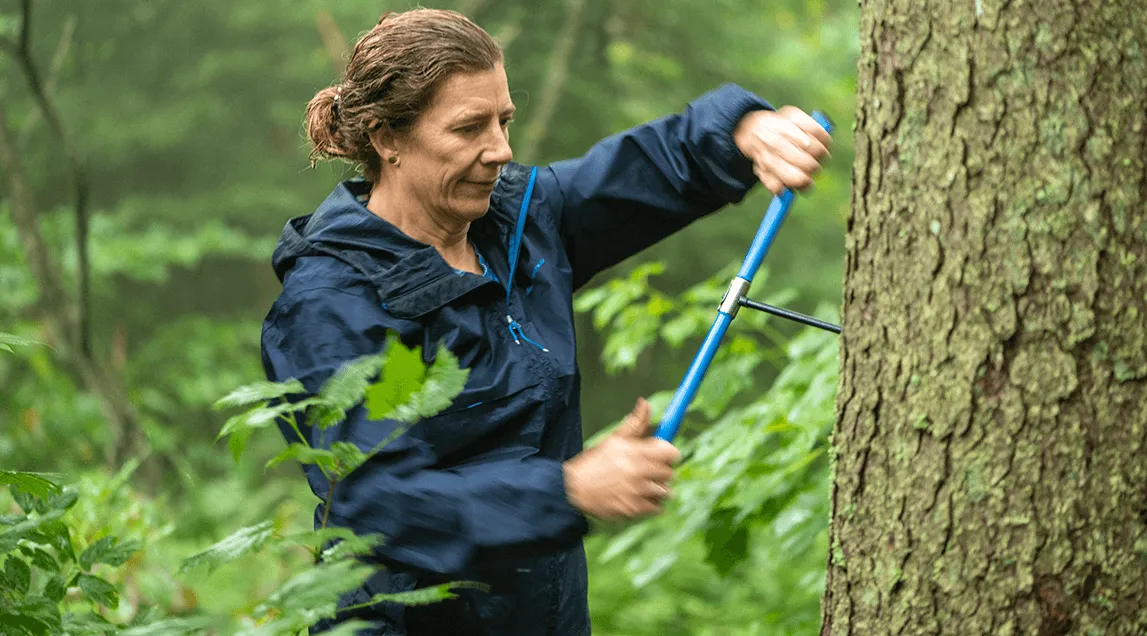Professor Shelly Rayback looks at the past through nature’s storybook: tree rings. That’s the work she broke down April 27 during the final full professor lecture of the year.
Rayback, who has been with the Department of Geography since 2005, discussed research that spans from the heart of the Green Mountains to the Canadian Arctic in her talk at Waterman Hall that night. The presentation was part of a College of Arts and Sciences series that commemorates professors who have achieved the highest faculty rank and highlights their work.
Dendrochronology, the study of tree rings, is Rayback’s specialty. Tree rings offer invaluable knowledge about the behavior of climate in the past, such as conditions of moisture and temperature. By obtaining information like that from different trees over a large scale, one can map the climate behavior of a geographic region.
What is special about this data is that it looks back much farther than any modern-day instrumental data can. The old age of trees and the time stamp that tree rings provide us, because of their annual growth rates, allow researchers like Rayback to look at specific and reliable data and unlock groundbreaking details on climate in the distant past.
The process of obtaining these tree rings is tedious, Rayback said. During her talk, she described how during a research trip, her team sometimes has to walk a few miles to get to the site. Then they choose 20 to 50 trees to core — a process in which they drill a hole in the tree and remove a pencil-shaped sample that contains tree ring information. It’s strenuous work. Researchers then look at the samples under a microscope in the lab.
Overall, said Rayback, the process can take between 25 and 120 hours for just one site.
In the lecture, she briefly described three of her research projects that use these techniques.
One study looked at moisture conditions in eastern North America over time through tree-ring records. Rayback collaborated with other dendrochronological researchers in the south- and mid-Atlantic regions to reconstruct climate histories of stream flow in these areas. This type of research is becoming increasingly valuable, she said, as climate change exacerbates global drought conditions and societal need for reliable water sources. Such research can reveal different moisture events and their length, intensity and geographic location in the eastern U.S.
On the same subject of Earth’s warming climate, Rayback is currently working on a project where she and her colleagues will look to reconstruct summer temperature for eastern North America from 1500 to 2021. When she completes this study, she hopes to combine data with similar research out west to construct a groundbreaking, continental-scale picture of the United States’ temperature history, something she said has never been done.
Rayback has used similar techniques to look at more than just trees: In the Canadian Arctic she examined the cross sections of evergreen dwarf shrubs to see how they respond to a rapidly changing arctic climate.
Rayback stressed the importance of pursuing research in the Arctic, calling the region “the canary in the coal mine.” Any changes happening to the climate are observed in the Arctic first, she said, so research like hers is crucial in understanding how the rest of the globe will react to climate stressors.
Outside of her research, Rayback has proven an asset to her department, too. She received the “Outstanding Service-Learning Faculty” award in 2011, served as an advisor to many students over the years and acted as co-director for the Environmental Sciences program for the past two years.
